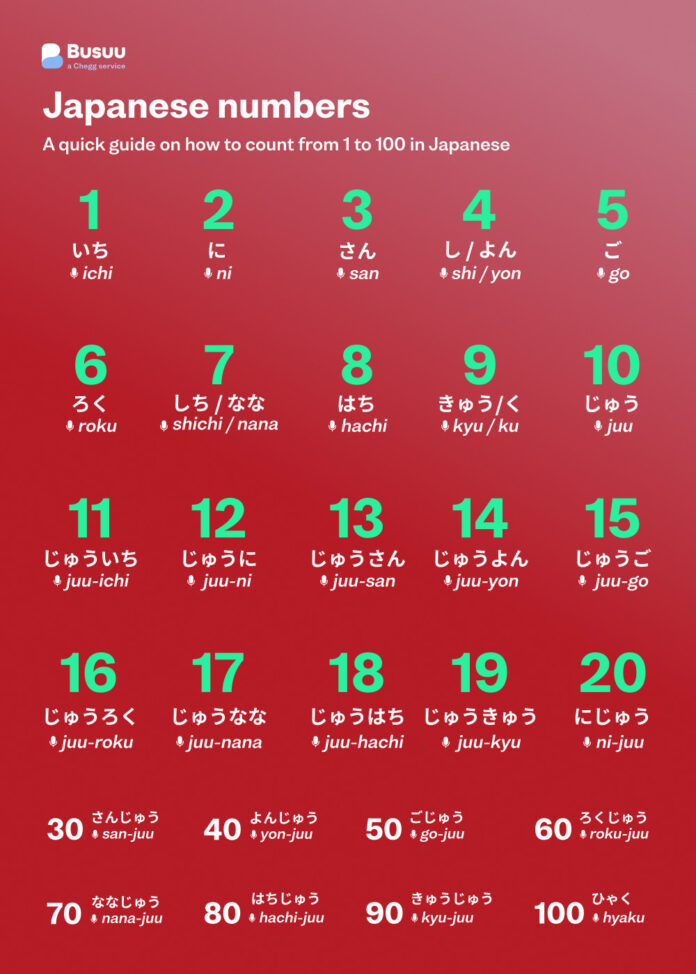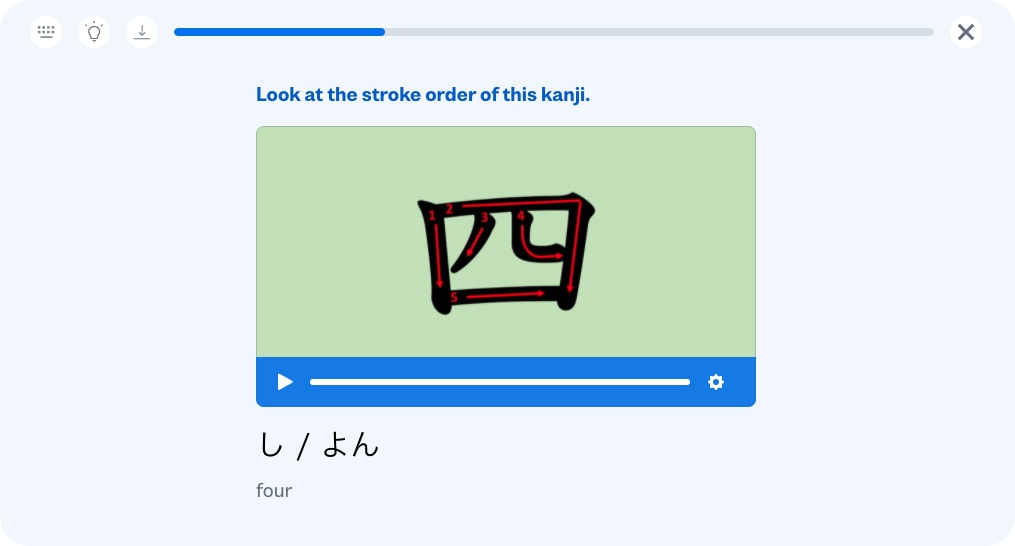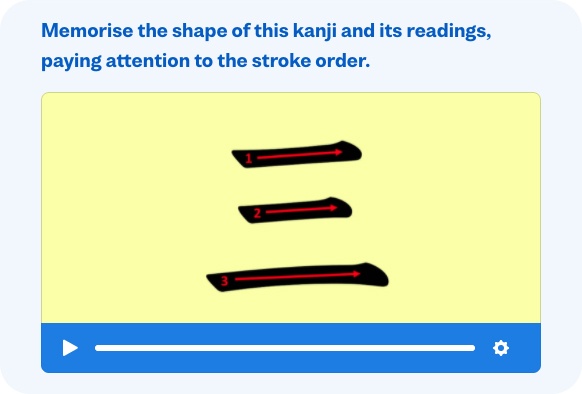Japanese numbers
Learn to count from 1 to 100
You’ll be relieved to hear that Japanese numbers are fairly simple to learn!
While learning a new system of writing and reading – not to mention tricky bits down the line like Japanese honorifics – can be tough when you’re getting started, numbers are an easy win early on.
After 1 to 10, Japanese numbers follow a logical pattern, with a few exceptions.
In this guide, we’ll show you how to get started reading, saying and understanding Japanese numerals with ease.
Ready? Let’s jump in.

We’ll start off with 1 to 10 in Hiragana. Hiragana is the first alphabet most students Japanese learn.
This is the biggest hurdle you need to jump over to become a Japanese numbers master. If you can get this – and you can – you’ll be on your way to easy street.
Here we go:
Japanese numbers: 1 to 10
| Hiragana | English | Letter-by-letter breakdown | Phonetics |
|---|---|---|---|
| いち | one | い (i)ち(chi) | ichi |
| に | two | に (ni) | ni |
| さん | three | さ(sa) ん (n) | san |
| し / よん | four | し(shi) / よ(yo)ん(n) | shi / yon |
| ご | five | ご (go | go |
| ろく | six | ろ(ro)く(ku) | roku |
| しち / なな | seven | し(shi)ち(chi) / なな(nana) | shichi / nana |
| はち | eight | は(ha/wa)ち(chi) | hachi |
| きゅう/く | nine | きゅ(kyu)う(u) /く(ku) | kyu / ku |
| じゅう | ten | じゅ(ju)う(u) | juu |
If you’ve already learned Hiragana, all these characters should be familiar to you.
If not, this is a great first step.
Not much of a reader, but hungry for more Japanese letters?

Busuu’s free online Japanese course lets you skip straight to learning more hiragana. Plus, you can get the skinny on Japanese numbers with Busuu’s specialised unit on the subject.
The best bit? If you can memorise the names for Japanese numbers 1 to 10, you’re well on your way to being able to say any Japanese number.
Top tip:
You’ll notice that 4, 7 and 9 all have two possible readings.
These two names are basically interchangeable when you’re counting in Japanese. Any native speaker will know both versions.
In times past, the Japanese created the preferable alternatives, yon, nana, and kyu, because of superstition around the sounds shi, shichi and ku (which can mean “death”, “place of death” and “agony”). But in practice, the different readings are largely just chosen based on context – telling time versus counting things, for example.
You’ll notice that, after 10, only those preferred pronunciations – yon, nana and kyu – are used for 4, 7 and . So for double-digit numbers ending in a 0, like 40, we usually say _yonjuu and not shi juu.
Once you have a solid grasp on 1 to 10, we can move on.
Here’s how you construct Japanese numbers 11 to 19:
10 + the number that’s missing to make the number you want
So 11 in Japanese is “10-1”, or juu-ichi / じゅういち.
Here’s 11 to 19, just so you can see it in practice.
Counting from 11 to 19 in Japanese
| Hiragana | English | Phonetics |
|---|---|---|
| じゅういち | eleven | juu-ichi |
| じゅうに | twelve | juu-ni |
| じゅうさん | thirteen | juu-san |
| じゅうよん | fourteen | juu-yon* |
| じゅうご | fifteen | juu-go |
| じゅうろく | sixteen | juu-roku |
| じゅうなな | seventeen | juu-nana* |
| じゅうはち | eighteen | juu-hachi |
| じゅうきゅう | nineteen | juu-kyu* |
Easy, right?
Next, we need to look at double-digit numbers beyond 19. We’ll start with multiples of 10, the numbers that end in 0 – so 20, 30, 40 and so on.
Forming big numbers like 20, 30, 40 and beyond is simple! We just need to say the first number followed by juu / じゅう.
That is, 20 is said “2-10”, or ni-juu / にじゅう. The only exception is 100, which is hyaku / ひゃく, made up of hya / ひゃ and ku / く.
That one you’ll just have to memorise.
Let’s have a look at how that works:
Japanese numbers: simple double-digit numbers
| Hiragana | English | Phonetics |
|---|---|---|
| にじゅう | twenty | ni-juu |
| さんじゅう | thirty | san-juu |
| よんじゅう | forty | yon-juu |
| ごじゅう | fifty | go-juu |
| ろくじゅう | sixty | roku-juu |
| ななじゅう | seventy | nana-juu |
| はちじゅう | eighty | hachi-juu |
| きゅうじゅう | ninety | kyu-juu |
| ひゃく | one hundred | hyaku |
It’s nice when things just work, isn’t it?
Last but not least, let’s take a look at how to put everything together to make double-digit numbers that don’t end in 0 – wild numbers, like 23 and 58 and, dare we say, 97.
Let’s get cracking.
To say a specific number between 21 and 99, we just use the following structure:
First number + じゅう (juu) + second number
For example, for 21, we would say “2-10-1”, or ni-juu-ichi / にじゅういち.
Here are a few more examples:
Complex double-digit Japanese numbers
| Number | Formation | Hiragana | Phonetics |
|---|---|---|---|
| 23 | two-ten-three | にじゅうさん | ni-juu-san |
| 49 | four-ten-nine | よんじゅうきゅう | yon-juu-kyu |
| 58 | five-ten-eight | ごじゅうはち | go-juu-hachi |
| 97 | nine-ten-seven | きゅうじゅうなな | kyu-juu-nana |
And there you have it! If you’ve followed all that, you now officially have a solid foundation in Japanese numbers.
Now, you can practise counting by translating numbers you see around you in your day-to-day life!
Want to learn more about Japanese? Or another language, perhaps?

Busuu is an app that helps you learn languages like Japanese (and 12 others) 4x faster than traditional language study.